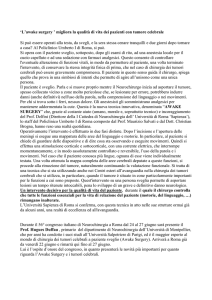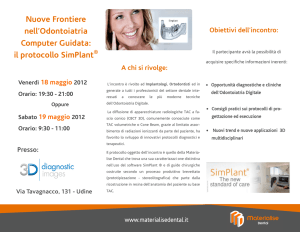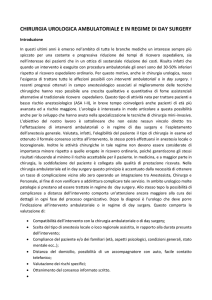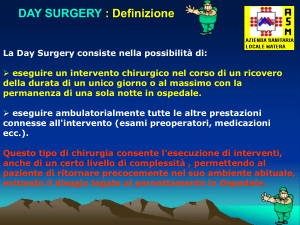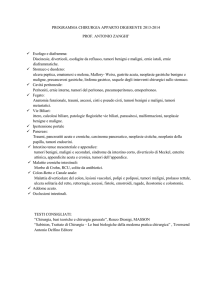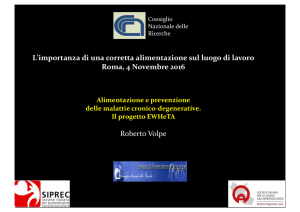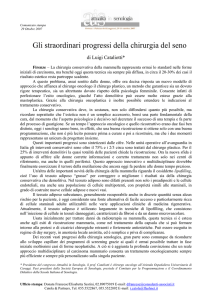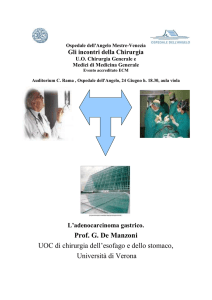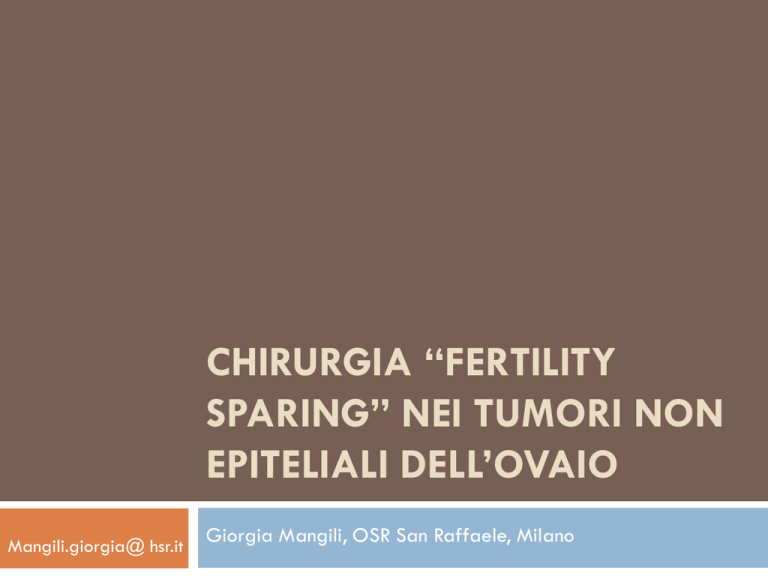
CHIRURGIA “FERTILITY
SPARING” NEI TUMORI NON
EPITELIALI DELL’OVAIO
Mangili.giorgia@ hsr.it
Giorgia Mangili, OSR San Raffaele, Milano
CHIRURGIA FERTILITY SPARING
Trattamento chirurgico che dia successivamente la
possibilità di procreare
Età fertile.
Prognosi non modificata dalla terapia.
Tumori dello stroma e dei cordoni sessuali
Tumori germinali
Menopausa
Infertilità per chirurgia
POF da chemioterapia
TUMORI OVARICI DELLO STROMA E
DEI CORDONI SESSUALI
Tumori a cellule della granulosa
Tecoma-fibroma
Tumori a cellule di Sertoli-Leydig
Ben differenziati, tumori a cellule di Sertoli-Leydig moderatamente
differenziati, tumori a cellule di Sertoli-Leydig cell tumor indifferenziati
(sarcomatoidi), retiformi
Tumori dei cordoni sessuali a tubuli annulari, ginandroblastoma
Tumori a cellule lipoidee: luteoma stromale, tumori a cellule di
Leydig, non classificati
TUMORI A CELL SERTOLI-LEYDIG
TRATTAMENTO
Trattamento standard:
Isterectomia addominale totale con
annessiectomia bilaterale e staging
chirurgico addominale
CARATTERISTICHE
Chirurgia conservativa nelle donne
desiderose di prole o in età fertle
La maggior parte è
diagnosticata al I stadio.
Non linfadenectomia.
Chemioterapia adiuvante
G2-3 e/o elementi
eterologhi.
Relapse nel primo anno,
raro dopo il 5° anno.
37 anni età mediana (range 16–76).
Fertility-sparing: 11 (52,3%)
Annessiectomia
monolaterale 10 (47,6%)
Enuclezione 1 (4,8%)
Stadiazione (71,4%)
Gyn Onc 2012
GRANULOSA OVARIAN TUMORS
0.5 - 0.9 casi per 100.000 donne /anno (Parking 2003)
2%-5% dei tumori dell’ovaio (About 1997, Schumer 2003)
Diagnosi età perimenopausale (About 1997, Abu-Rustum
2006)
Recidive tardive (Uygun 1993)
Sopravvivenza : stadio I 75%-90 %, II 55%-75%, III/IV
22%-50% (Colombo 2007)
Mortality rates circa 20% (Evans1980 , Fox1975)
DIAGNOSIS
made by histology at the time of surgical
excision
STAGING
exploration of pelvis and abdominal cavity
peritoneal washing
peritoneal biopsies
omental biopsy
biopsy of any sospicious area
DEBULKING
remove as much gross tumor as possible
total
abdominal
hysterectomy,
bilateral salpingo-oophorectomy and
complete tumor debulking is preferable
if fertility is not an issue
Brown et al, Gynecol. Oncol. 2009, Schummer et al, J Clin Oncol
S
U
R
G
I
C
A
L
M
A
N
A
G
E
M
E
N
T
CONSERVATIVE SURGERY
Annessiectomia monolaterale nelle giovani donne
Rara la bilateralità (2%-8%).
Biopsia endometriale
La maggior parte degli studi non ha mostrato
differenze fra chirurgia conservativa e demolitiva
negli stadi iniziali
Savage et al, Clin Oncol 1998, Bjorkholm et al, Gynecol Oncol
Pankratz et al, Obstet Gynecol 1978, Sjostedt et al, Acta Obstet Oncol 1998
RISK FACTORS FOR RECURRENCE (I stage)
CONSERVATIVE SURGERY: MITO DATA
stage
conservative
surgery
radical
surgery
relapse cons.
relapse rad.
17.1%
NS
NS
NS
NS
IA
56 (61.5%)
21
35
19%
IB
3 (3.3%)
0
3
-
IC
21 (23%)
5
16
60%
44%
IX
11 (12%)
4
7
75%
43%
TOT
91
30
61
33%
26%
MALIGNANT OVARIAN GERM
CELL TUMORS
Primordial
Germ Cell
5% dei tumori ovarici
Differenti tipi istologici
Età giovane
Dysgerminoma
Embryonal
Carcinoma
Stadi iniziali
Marker specifici
Extraembryonic
Differentiation
Embryonic
Differentiation
Chemiosensibiltà
Endodermal
Sinus Tumor
Choriocarcin
oma
Mature
teratoma
Immature
teratoma
HISTORY OF TREATMENT
PRESERVATION OF
FERTILITY
Fertility sparing surgery
+ BEP
NEW CHALLENGE
Histotype and stage
related treatment
Survival (80100%)
PLATINUM based
chemotherapy
Survival (5-20%)
Radical Surgery+/RT
PRESERVAZIONE FERTILITA’
Istotipo
Stadio
Bilateralità
Cromosomopatie
Tipo di chirurgia
Trattamento chemioterapico
CHIRURGIA CONSERVATIVA SEER
Totale
1988-1992
1993-1997
1998-2001
conservativa
313(58.9%)
87(58.4%
119(57.2)
107 (60.1)
demolitiva
222(41.5)
62(41.6)
89(42.8%)
71 (39.9%)
Soppravvivenza
• Conservativa 97.9%
• Demolitiva
95.6%
Chan 2008
CHIRURGIA CONSERVATIVA
Conservativa
demolitiva
Pazienti
92 (74.8%)
31 (25.5%)
Età media
24.7
36.7
Stadi iniziali
% recidive
Conservativa
17.4% NS
demolitiva
19.3%
Stadi avanzati
conservativa
28.5% NS
demolitiva
26.6%
Mangili e MITO 2011
Confronto fra terapia conservativa e
demolitiva
Non differenze fra chirurgia demolitiva e conservativa
BILATERAL MALIGNANT OVARIAN
GERM CELL TUMORS
La bilateralità è rara (4.3%)
Valutazione intraoperatoria
Mature teratoma (5% prima chirurgia e follow up)
Disgerminoma (15%)
Iperstimolo
Malattia residua sull’ovaio potrebbe essere lasciata con
lo scopo di preservare la fertilità
Non biopsiare l’ovaio controlaterale assenza di lesioni
macroscopiche
(59 patients with previous ovarian wedge resection, 40
of whom were found to have pelvic adhesions. (Buttran
1975)
CLINICAL CASE
PRONTO SOCCORSO
24 anni , nullipara
addome acuto iperpiressia
US: massa annessiale (12 x10x8 cm)
Markers:
βHCG= 300 mUI/mL
α FP= 20200 ng/dL
LDH= 2542 UI/L
E. istologico estemporaneo: massa annessiale: neoplasia
germinale mista; ovaio controlaterale: disgerminoma
CLINICAL CASE
Mixed ovarian germ cell tumor
(yolk sac, dysgerminoma,
embrional carcinoma)
BEP NED
Ovaio controlaterale :
DISGERMINOMA
OVARIAN HYPERSTIMULATION
16 year old girl
Vaginal bleeding and pelvic
pain since 30 days
Markers:
βHCG: 24.800 mUI/mL
αFP: 8.204 ng/dL
TC: pelvic mass 14x12x13 cm
Mixed ovarian germ cell tumor
(yolk sac, dysgerminoma,
embrional carcinoma)
…Not Biopsied!
Un anno dopo…
Teratoma maturo
CONSERVARE L’UTERO?
Disgenesia gonadica : rimozione delle gonadi
Gonadoblastoma
Disgerminoma e e yolk sac
2 pazienti con disgenesia gonadica XY hanno partorito
ricorrendo alla ovodonazione
FERTILITA’ DOPO CHEMIOTERAPIA
Ripresa cicli
mestruali
N. Pazienti che
hanno partorito
Pektasides,1987
17
16/17 (94%)
5
Brewer, 1999
14
13/14 (93%)
3
Low, 2000
47
43/47 (92%)
19
Zanetta, 2001
81
80/81 (99%)
16
Tangir, 2003
40
28/40 (69%)
29
Gershenson, 2007
71
62/71 (87,3%)
24
de
40
39/40
(97%)
16
Cicin 2009
29
28/29 (96,5%)
8
Tasso di menopausa precoce circa il 3%
FERTILITA’ ( MITO 9)
92 pazienti con chirurgia conservativa
Ricerca del
concepimento
No
Si
Chemioterapia
adiuvante
Concepimenti
Gravidanze a
termine
Aborti spontanei
Interruzioni
volontarie
15
3(20%)
Ripresa ciclicità
mestruale
Menopausa precoce
96.6%
3.4%
12(80%)
7
16
10
4
2
2 pazienti con disgenesia gonadica XY hanno avuto 2
gravidanze, ricorrendo alla fecondazione eterologa
Pazienti che hanno
concepito
Stadio IA
12
7
Stadio IC
3
Stadio IIIC
2
Disgerminoma
8
Teratoma immaturo
2
Tumore del seno
endodermico
1
Misti
1
VALUTAZIONE FERTILITA’
Limiti degli studi
Numero limitato di pazienti
Giovane età delle pazienti
Follow up troppo brevi
Perdita al follow up delle pazienti
Mancanza di dati per diagnosticare la POF
DANNO GONADOTOSSICO: riserva ovarica – trattamento chemioterapico
CHEMIOTERAPIA - AMENORREA
80%
30-70%
< 20%
IMMATURE TERATOMA
30% of MOGCT
Rarely bilateral
Peritoneal spread
CA19.9
FERTILITY SPARING SURGERY + BEP
With the exception of Stage IA G1
Are we overusing adjuvant chemotherapy in stage IA G2–3 and
IB–IC?
Stage I immature teratoma: 28 patients
Grade 1:
9 patients
IA: 8
patients
Grade 2:
12 patients
IC: 1
patients
Surgery in
9 patients
IA: 5
patients
IB: 2
patients
Surgery in
8 patients
No Recurrences
Grade 3:
7 patients
IC:5
patients
IA: 6
patients
Surgery+ BEP
in 4 patients
Surgery in
2 patients
3 Recurrences:
IC
Surgery+ BEP
in 2:Immature
teratoma
1 Recurrence:
IA
Surgery
in 1:Mature
teratoma
IC: 1
patients
Surgery+ BEP
in 5 patients
2 Recurrences:
IA
Surgery in 3 :
Mature teratoma
After a median follow up of 59 months all patients are NED
Mangili Gynecologic Oncology (2010)
STAGE I DYSGERMINOMA
50% of MOGCT
75% 10-30 years
Lymphatic spread
10-15% Bilateral
CA 125 - LDH
FERTILITY SPARING SURGERY + BEP
With the exception of Stage IA
Apparent stage IA management?
Gynecologic Oncology (2011)
26 patients
Dysgerminoma
Stage IA
Complete Surgical
Staging in 5 patients
Incomplete Surgical Staging
in 21 patients
No adjuvant
chemotherapy in 5
patients
Ajuvant
Chemotherapy
in 7 patients
No adjuvant
chemotherapy in
14 patients
No relapse
No relapse
3 Recurrences
Individuare le pazienti con riserva ovarica ridotta :
Ormone antimulleriano
Ridotto nelle pazienti sottoposte a
trattamento chemioterapico
Le pazienti con GCT hanno un rischio di POF
Giovane età
Chirurgia demolitiva sugli annessi
Chemioterapia con farmaci a rischio intermedio per POF
Introdurre nel follow up la valutazione della
PMA: CRIOCONSERVAZ OVOCITARIA
Individuare le pz a rischio
Programmare preservazione
della fertilità
PRELIEVO OVOCITARIO
CRIOCONSERVAZIONE
IRCCS San Raffaele, Milan
Gynecology and Obstetrics Department
Prof. M. Candiani
GYNECOLOGIC ONCOLOGY TEAM
Grazie per
l’attenzione

